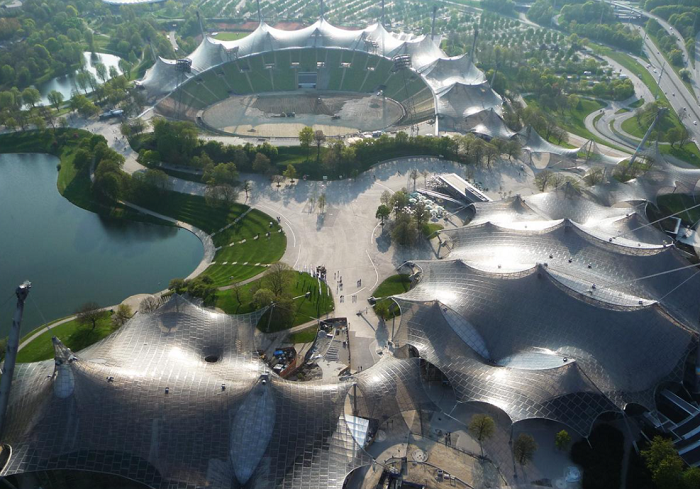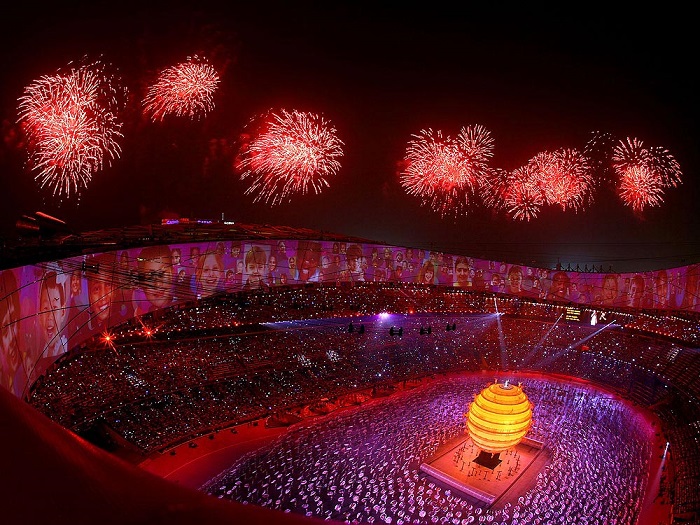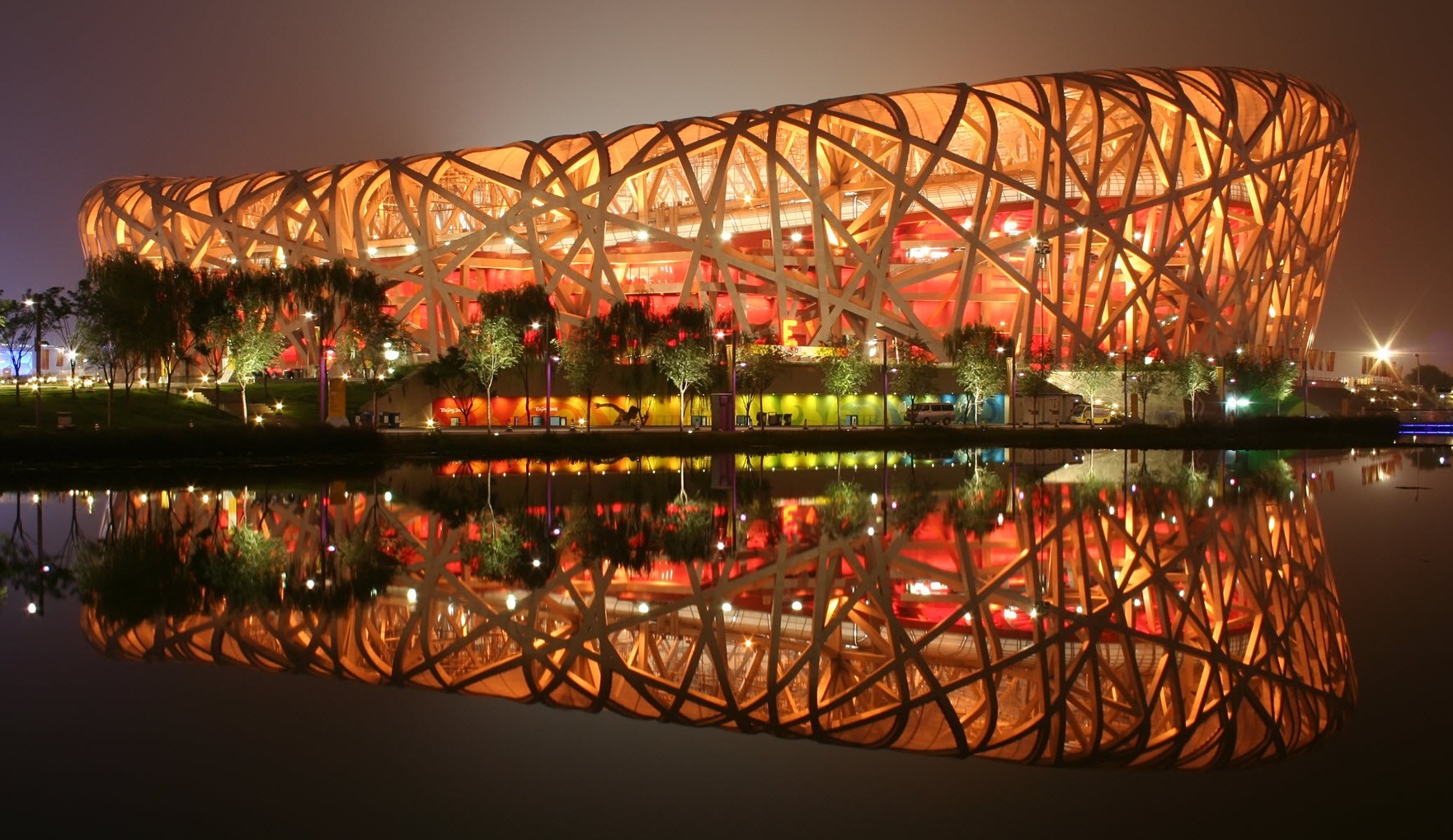ISABEL RUBIO ARROYO | Tungsteno
In 2008, Michael Phelps swam the 200m butterfly in 1 minute 52 seconds, while in 2012 Usain Bolt ran the 100m dash in 9.63 seconds. The best athletes in the history of mankind have competed in the Olympic Games. But for many years the event did not only award sporting medals—some arts, such as architecture, were also Olympic disciplines until the mid-20th century. In fact, if this event is characterised by anything, it is that it has changed the physiognomy of the host cities and has been the pretext for constructing some emblematic sports facilities—from the Olympic Stadium in Montjuïc (Barcelona) to the National Stadium in Beijing and the Aquatics Centre in London.
Munich Olympic Park (1972)
In 1972, at the Munich Olympics, 11 members of the Israeli Olympic team were taken hostage and killed by militants affiliated with the Palestinian group Black September. The architectural wonders of the event, as well as the sporting achievements, were completely overshadowed by this act of terrorism. Here the jewel in the crown was the Munich Olympic Stadium, designed by architects Günter Behnisch and Frei Otto; the latter won the prestigious Pritzker Prize in 2015.
Resembling a giant tent, the stadium roof designed by Otto employed a network of cables tensioned by a multitude of supporting masts that provide the necessary support to hold up the roof membrane. The cables that make up the mesh are connected by cast steel knots. With a roof surface area of 74,800 square metres and a capacity of 70,000 spectators, the stadium was a milestone in the history of architecture. Architect Juan María Songel, an expert on Otto's work, explains in Líbero magazine that it showed "on a large scale innovative structural systems based on the resistance capacity of steel cables," as well as using "geometric forms unusual in modern architecture."

The Munich Olympic Stadium resembles a large tent made up of a network of cables tensioned by multiple supporting masts. Credit: Christine Kanstinger / The Hyatt Foundation.
Montjuïc Olympic Stadium (1992)
The 1992 Olympic Games in Barcelona involved one of the biggest urban transformations in the city's history. The city opened up to the sea and gained two kilometres of beach, as well as an entire neighbourhood—the Olympic Village —and new airport terminals. Among the architectural successes, the Montjuïc Olympic Ring, which was the nerve centre of the great sporting event, stands out. This area was designed by the architects Carles Buxadé, Joan Margarit, Federico Correa and Alfons Milà. In addition to remodelling existing facilities such as the Montjuïc Olympic Stadium and the Picornell Swimming Pools, new facilities were built, such as the Palau Sant Jordi sports hall and a communications tower designed by the Valencian engineer and architect Santiago Calatrava.
The Montjuïc Olympic Stadium was the venue for the opening and closing ceremonies of the Olympic Games, as well as the athletics events. This structure, designed by the architect Pere Domènech i Roura, was inaugurated in 1929 as part of the Barcelona International Exhibition. For the 1992 Olympics, the entire stadium was remodelled, except for its façade, which still retains its original appearance. With a capacity of 60,000 people, the stadium has hosted other sporting, musical and corporate events since the Olympic Games.
The 1992 Barcelona Olympics were one of the biggest urban transformations in the city's history. Credit: Clara Films.
Beijing National Stadium (2008)
Some birds build elaborate nests to raise their chicks or to use them year round. The Swiss architects Jacques Herzog and Pierre de Meuron created the Beijing National Stadium with the same idea in mind: "To develop an architecture that will continue to be functional following the Games in 2008, in other words, to create a new kind of urban site that will attract and generate public life in this part of Beijing." The structure has been dubbed the "bird's nest" because of the tangle of metal pieces that make it up, weighing more than 40,000 tonnes. "The components look like a chaotic thicket of supports, beams and stairs, almost like an artificial forest," say its creators.
The stadium is 330 metres long, 220 metres wide and 69 metres high and is characterised by its sustainable design. The architects Herzog & de Meuron emphasise that dispensing with a solid, closed façade facilitates the natural ventilation of the infrastructure. In addition, the stadium has a system that collects rainwater and purifies it for reuse. With a capacity of 91,000 spectators, it was the main venue for the Olympic track and field events, as well as the opening and closing ceremonies of the Olympic Games and some matches of the Olympic Football Tournament. In 2022 it is expected to host the opening and closing ceremonies of the Winter Olympic Games.

The Beijing National Stadium is a tangle of metal parts weighing more than 40,000 tonnes. Credit: Wuqiang_beijing.
London Aquatics Centre (2012)
In 2004, Zaha Hadid became the first woman to win the Pritzker Architecture Prize. A few years later she was commissioned to design the star structure of the 2012 Olympics: the London Aquatics Centre. To build it, she was inspired by the geometric flows of moving water. In fact, the roof is a wave of some 1,040 square metres that rises up, enclosing the Olympic pools used for the swimming, diving and synchronised swimming competitions.
Until 1908, Olympic swimming events were held in open water—rivers and lakes—after which they were moved to swimming pools. The pools at the London Aquatics Centre have movable floors and structures to change their depth and size. While the venue had a seating capacity of 17,500 during the Olympic Games, it was renovated after the event and now has capacity for 2,800 spectators and space to add an additional 1,000 seats for major sporting events. In addition to the Olympic Games, the building has hosted other competitions such as the International Swimming League and the FINA World Diving Series. Today it is also open to the general public.

The roof of the London Aquatics Centre is a wave of some 1,040 square metres that encompasses the Olympic pools that hosted the 2012 Olympics. Credit: Zaha Hadid Architects.
For decades, the Olympics have been an excuse to carry out urban transformations of cities and to engage in pharaonic, multimillion-dollar construction projects that would be impossible without this global showcase. Many countries have taken advantage of the sporting event to demonstrate their capacity to build innovative infrastructure. Tokyo plans to kick off the next Olympic Games on 23 July. The new Japan National Stadium, designed by the famous Japanese architect Kengo Kuma, has been constructed on the site of the old national stadium erected for the 1964 Olympic Games. This new iconic structure will in theory host the opening ceremony of what is likely to be the biggest sporting event in history.
· — —
Tungsteno is a journalism laboratory to scan the essence of innovation. Devised by Materia Publicaciones Científicas for Sacyr’s blog.
